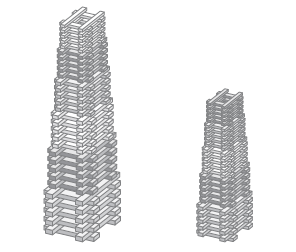Rod Towers
 All Classroom Lessons
All Classroom Lessons
A Lesson for Kindergarten, First, and Second Grade
by Vicki Bachman
In this activity, children build and then determine the height of Cuisenaire rod towers. Students build a tower with a partner, decide the measurement tool to use, measure their tower, and then in a whole-class discussion make comparisons between the towers. Rod Towers is excerpted from Vicki Bachman’s new book, Sizing Up Measurement: Activities for Grades K–2 Classrooms (Math Solutions Publications, 2007).
Instructions
-
Prior to this lesson, provide a session for the children to explore the Cuisenaire rods or blocks. Once children are comfortably acquainted with the materials, ask them to describe what they notice. Discuss the variations among the materials and focus on similarities and differences to develop mathematical vocabulary.
-
Begin Rod Towers by explaining that tall buildings in cities are called skyscrapers. Ask the children why that name might have become popular. Explain that tall buildings are found mostly in cities because people build upward when land is scarce. Ask the children to tell about tall buildings that they have seen. Ask them to describe some of the things that might be involved in constructing a tall building.
-
Explain to the students that they are going to work with a partner to build a tower and then measure its height. Show the children how to position the Cuisenaire rods: beginning with the two longest rods and placing them parallel to one another, then stacking the next two in the opposite direction, and continuing upward, eventually decreasing in size as they go. Discuss the kind of cooperation it will take to work together to build a tower. Have several children share ideas about fair teamwork. When the expectations have been established, describe the procedures for distributing the materials.

-
Organize the class into partners. Let the children know how much work time they will have by using a timer or by establishing a stopping point on a clock in the room. Explain that when it is time to stop building, you will give a signal, and each pair will decide how to measure their tower. Show the children the variety of measurement tools that they may choose from.
-
After the children have had a reasonable amount of time (about fifteen minutes) to build, stop the class and ask students to find a way to describe how tall their buildings are. Some of the children may use their bodies to make a direct comparison by standing next to the tower, holding their hands up to the top of the tower, and saying, for instance, “It’s up to my stomach!” Ask the children if they think any of the towers are the same height and discuss ways that students might determine the answer without moving the towers.
-
Next, have partners decide on a measuring tool, measure their tower, and then, when everyone is ready, report back to the class about the height of their structure. Most likely, you will hear comments like “This is how far our tower comes up on the meter stick,” “Our tower was twenty-six cubes tall,” and “Our tower was thirty-one blocks high.” Discuss the various measurement methods the children used.
-
Have children, either alone or in pairs, draw their tower and label it with its height. Save these illustrations so that the children can compare the heights from this lesson with those of towers they build in the future.
Extensions
-
Have children build two towers of the same height out of different materials.
-
Have children create a tower and then build another that is twice the height or half the height of the original.
-
Challenge the children to build an inverted tower, with the smallest blocks on bottom.
-
Have children create drawings of tall buildings and describe their relative heights.
featured in Math Solutions Online Newsletter, Fall 2007, Issue 27

Comments